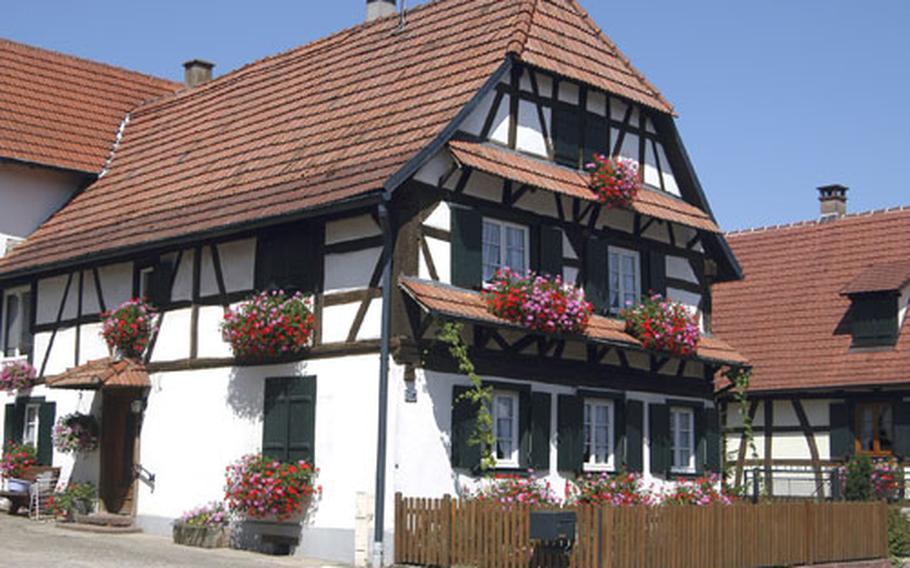
Besides being a mecca for pottery shoppers, Betschdorf, France, is full of old half-timber houses decorated with flower boxes. (Michael Abrams / S&S)
Betschdorf and Soufflenheim are two towns in the northeast of France’s Alsace region, an area known for excellent wines, hearty food, charming villages and — this is where the two towns come in — pottery.
Both towns have main streets dotted with pottery shops and potters’ workshops. But that is where much of the similarity ends.
Betschdorf is a good-looking town with lots of old, half-timbered houses adorned with colorful flower boxes. Soufflenheim is rather plain, and, without its pottery shops, probably would draw nary a tourist.
Soufflenheim does have the more colorful pottery, however. Its pieces are yellow, blue, green and brown and decorated with flowers, birds and people dressed in traditional Alsatian garb. The pottery of Betschdorf is basically a bluish-gray, decorated in cobalt blue.
In both towns, the pottery is basically made the same way. First, a potter forms the object on a wheel. It is dried and a thin film of clay is applied to give it its basic hue. Then it is decorated, glazed and baked at about 1,800 degrees Fahrenheit.
This is also where the pottery of the towns differ. Betschdorf’s is salt-glazed. While it is baking in the oven at about 2,200 degrees Fahrenheit, salt is added to the oven for the glaze. This makes the pottery very durable, and because it is durable, it is (or was) often used to store things like sauerkraut and spirits. Before plastic took over, the salt-glazed pottery was even used to make pipes for plumbing.
If Betschdorf’s pottery is for storage, then Soufflenheim’s is for cooking. Indeed, many Alsatian specialties — Baeckeoffe, a casserole, Choucroute garni, a sauerkraut and sausage dish, and Kougelhopf, a dry cake — are still made using the pottery.
Potters in both towns make dishes, wine coolers, pitchers, plates, flower pots and much more in their workshops.
Much of the history of Betschdorf’s pottery can be seen in the town’s Musée de la Potterie, or pottery museum. An audio tour guides you through the rooms and ends at a display of works by today’s potters.
In both towns, it is possible to visit some workshops and see how the pottery is made. But most people come to shop.
The pottery is not cheap, but affordable. A casserole big enough to cook Baeckeoffe for four people costs around 45 euros. A wine cooler costs around 20 euros and a Kougelhopf mold somewhere in between. If you just want a souvenir of your visit or a small present for family back home, you can find something for less than 10 euros.
Both towns have pottery festivals. Betschdorf’s, called the Night of Ceramics, is Sept. 2 from 6 p.m. to midnight, followed by an international potters’ market on Sept. 3.
Soufflenheim’s is every other year, with the next one in September 2007.
On the QTDirections: Betschdorf and Soufflenheim are in eastern France, on the German border north of Strasbourg and west of Baden-Baden, Germany. From the Heidelberg/Stuttgart direction, take autobahn 5 south to the Baden-Baden exit and follow signs on Highway 500 toward Iffezheim. The road becomes D-4 after crossing the Rhine and entering France, and intersects with A-35. Go north on A-35 for one exit to Betschdorf, or south one exit to Soufflenheim. From Kaiserslautern or Mannheim, take A-6 to A-61, head south to the juncture with A-65 and follow it to France where it becomes A-35. Then follow the directions above. Road D-344 connects the two towns.
Times: The pottery museum in Betschdorf is open 10 a.m. to noon and 2-5:30 p.m. Monday through Saturday; on Sundays and French holidays it is open 2 to 5:30 p.m. Most pottery stores are open Monday through Saturday, but close from noon to about 2 p.m. for lunch. Many are open Sunday afternoons.
Costs: The museum costs 3.50 euros for adults, and 1 euro for children.
Food: Each town has a couple of restaurants along their main streets. For Alsatian specialties, try Au Boeuf in Soufflenheim, and the Restaurant Au cygne or Restaurant Au boeuf in Betschdorf .
Information: Each town has a tourist information bureau: www.betschdorf.com and www.ot-soufflenheim.fr.
— Michael Abrams